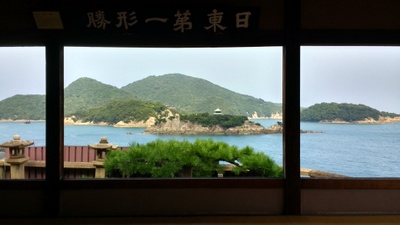Difference between revisions of "Fukuzen-ji"
From SamuraiWiki
Jump to navigationJump to search (Created page with "right|thumb|400px|The view of [[Sensuijima from the Taichôrô]] *''Established: c. 950'' *''Japanese'': 海岸山千手院福禅寺 ''(Kaig...") |
|||
| Line 9: | Line 9: | ||
In the [[Genroku]] era, around [[1690]], a guesthouse was constructed adjacent to, and attached to, the temple's ''hondô'' (main hall). The guestroom is in simple ''[[irimoya]]'' construction, with 11.8 meter beams, and a tiled roof. | In the [[Genroku]] era, around [[1690]], a guesthouse was constructed adjacent to, and attached to, the temple's ''hondô'' (main hall). The guestroom is in simple ''[[irimoya]]'' construction, with 11.8 meter beams, and a tiled roof. | ||
| − | [[Yi Bang-eon]], a member of the [[1711]] Korean mission to Edo, famously declared the view of the [[Inland Sea]] from the guesthouse to be the greatest in Japan. A member of the [[1747]] mission, [[Hong Kyung Hae]]<--洪景海-->, later composed a piece of calligraphy naming the guesthouse "Taichôrô," or "Tower Facing the Tides." | + | [[Yi Bang-eon]], a member of the [[1711]] Korean mission to Edo, famously declared the view of the [[Inland Sea]] from the guesthouse to be the greatest in Japan. A member of the [[1747]] mission, [[Hong Kyung Hae]]<!--洪景海-->, later composed a piece of calligraphy naming the guesthouse "Taichôrô," or "Tower Facing the Tides." |
{{stub}} | {{stub}} | ||
Revision as of 12:47, 6 October 2017

The view of Sensuijima from the Taichôrô
- Established: c. 950
- Japanese: 海岸山千手院福禅寺 (Kaiganzan Senjuin Fukuzenji)
Fukuzen-ji is a Shingon Buddhist temple in Tomonoura, Hiroshima prefecture, famous for its Taichôrô guest room, which hosted Korean embassies to Edo on a number of occasions.
The temple was founded in the Heian period, around 950.
In the Genroku era, around 1690, a guesthouse was constructed adjacent to, and attached to, the temple's hondô (main hall). The guestroom is in simple irimoya construction, with 11.8 meter beams, and a tiled roof.
Yi Bang-eon, a member of the 1711 Korean mission to Edo, famously declared the view of the Inland Sea from the guesthouse to be the greatest in Japan. A member of the 1747 mission, Hong Kyung Hae, later composed a piece of calligraphy naming the guesthouse "Taichôrô," or "Tower Facing the Tides."
References
- Plaques on-site.[1]